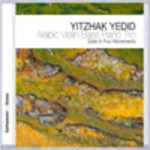Audio Sample
|
|
Performance by Sami Kheshaiboun, Ora Boasson Horev, Yitzhak Yedid from the CD Arabic violin bass piano trio |

$POA

This item may be available to purchase from the Australian Music Centre.
Please contact our Sales Department to confirm pricing and availability.
CD
Arabic violin bass piano trio : suite in four movements / Yitzhak Yedid.
Library shelf no. CD 2637 [Available for loan]

$POA

This item may be available to purchase from the Australian Music Centre.
Please contact our Sales Department to confirm pricing and availability.
Score & Part
Arabic violin bass piano trio : suite in four movements / Yitzhak Yedid.
Library shelf no. 785.2813/YED 2 [Available for loan]
Work Overview
Arabic Violin Bass Piano Trio is a
suite in four movements. The composition is a continuation of my
endeavour in Oud Bass Piano Trio (2005) to integrate
classical Arabic music, Arabic-influenced Jewish music and
contemporary Western classical music. This trio has therefore
been composed for performers who have expertise both in these
genres and in improvisation. The music makes manifest the
tensions between the ancient and the new, the religious and the
secular, the East and the West.
Arabic Violin Bass Piano Trio is an authentic expression of new
music which incorporates a wide spectrum of contemporary and
ancient styles. It creates a confluence between the Maqamat and
the heterophonic textures of Arabic genres (classical Arabic
music and Arabic-influenced Jewish music) and the compositional
approaches of contemporary Western classical music.
The suite consists of six major sections in the First Movement,
eight major sections in the Second Movement, four major sections
in the Third Movement and eight major sections in the Fourth
Movement. The sections have been created with a range of
different approaches, and musical elements have been repeated in
diverse ways. The superimposition and synthesis of a variety of
musical styles and contrasting compositional approaches and modes
have been made possible by an overall connectedness in the work.
This connectedness can, to a certain degree, be understood,
perhaps subconsciously, by experiencing the performance of the
piece or by listening to it without a break.
The titles of the work's major sections have been chosen to evoke
various musical images and to transfer ideas and thoughts that
inspired my composition. The titles reflect, or perhaps document,
events that occurred at the time the pieces were being composed.
They can be divided into three main categories. The first
category refers to Arabic musical forms and themes - for example,
Taqsim, dedicated to the day of tomorrow and Belly dancing in an
imaginary cult ritual. The second category refers to Jewish
prayers and Jewish themes - for example, The High Priest's
whispered prayer on Yom Kippur as he leaves the Holy of Holies
and a quote from the Yom Kippur prayer One, one and one, one and
two, one and three, one and four, one and five. The third
category refers to specific events that occurred while I was
composing the piece - for example, Image of a homeless Holocaust
survivor on the streets of Tel Aviv and The image of an old weary
man. As in Oud Bass Piano Trio, the titles of these
images have been chosen as a general guide to the feel of the
composition. Individual listeners may assemble them into a story,
according to their experiences, understanding or imagination.
Moreover, I believe the titles create a musical narrative and
convey emotions as well as presenting controversial religious
issues and, to some extent, contentious political issues in the
relatively safe haven of music making.
Arabic Violin Bass Piano Trio presents a model of
understanding and reconciliation that I wish would apply to the
day-to-day interactions between people, nations and religions.
Our past traditions and history should be remembered and
acknowledged and we should recognize that we are unable to change
them. However, we must also understand that we are the ones
creating the "new tradition", and that in doing so, we have the
responsibility - and, hopefully the willingness - to make changes
in a sensitive, inclusive and informed manner. It is our
obligation to build on the past for a better future, and
actively, perhaps through the universally understood language of
music, change negativity and hatred to positivity, hope and
peace. Surely this should be our mission!
Work Details
Year: 2009
Instrumentation: Arabic violin, double bass, piano.
Duration: 60 min.
Difficulty: Advanced
First performance: Mar 10. Henry Crown Symphony Hall, Jerusalem Theater, Israel
Subjects
- In the form/style of: Suites
Performances of this work
Mar 10: Henry Crown Symphony Hall, Jerusalem Theater, Israel
User reviews
Be the first to share your thoughts, opinions and insights about this work.
To post a comment please login.